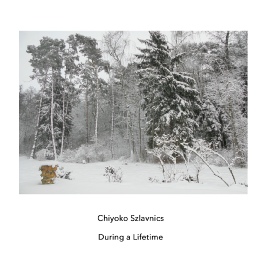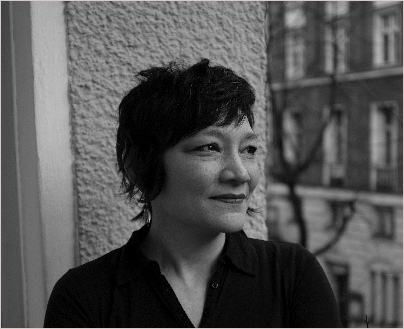Another Timbre TimHarrisonbre

at108 Chiyoko Szlavnics ‘During a Lifetime’ Canadian Composers Series #4
1. ‘During a Lifetime’ (2015) 18:20 Konus Quartett: Fabio Oehrli (soprano & alto saxophones) Jonas Tschanz (alto saxophone) Christian Kobi (tenor saxophone) Stefan Rolli (baritone saxophone)
2. ‘Freehand Poitras’ (2008) 9:00 Gordon Mackay & Mira Benjamin (violins) Anton Lukoszevieze (cello)
3. ‘Reservoir’ (2006) 26:20 Apartment House: Nancy Ruffer & Gavin Morrison (flutes) Jonas Kocher & Hannes
youtube extract Lingens (accordions) Simon Limbrick & Richard Benjafield (percussion)
Mira Benjamin (violin) Anton Lukoszevieze (cello) John Lely (technical assistance)

Chiyoko Szlavnics
The fourth disc in the Canadian Composers Series features the music of Chiyoko Szlavnics. The CD contains three works, two of which use sinewaves in conjuncton with acoustic instruments. The title track ‘During a Lifetime’ is written for sinewaves and saxophone quartet, an instrument on which Szlavnics herself used to perform. The final piece, ‘Reservoir’, is composed for sinewaves and an unusual instrumental octet, including two accordions, two flutes and two percussionists. The middle piece ‘Freehand Poitras’ is for string trio, but like the other works on the disc it is typified by the use of long sustained tones and slow glissandi.
In his introductory essay in the booklet accompanying the Canadian Composers Series CDs, Nick Storring writes about how Szlavnics’ use of sustained tones is often derived from line drawings that she does as part of the compositional process: “She deals with sound in a patiently shifting manner, through series of woven-together billows of quiet dynamism. Many of her pieces are effectively translated from drawings that she makes. Often consisting of interleaved matrices of fine lines, it's easy to grasp how their structures serve as foundations for her music. Several hint at an illusory world of perspective that exists between two and three dimensionality, simultaneously evincing depth and flatness.”
In this extract from her interview in the Canadian Composers Series booklet, Chiyoko Szlavnics talks about her love of sinewaves, but also the qualities that she values in acoustic instruments.
“Do you use sinewaves in most of the drawing pieces you’ve composed, and have you ever composed a piece that is just sinewaves without any instruments?
To answer the second question first, yes, around 2006 I worked a lot with sinewaves and I have a handful of pieces from then that are sinewaves only. In the last five years the majority of my compositions have included sinewaves, but I’ve reached the point where I’m wanting to separate them again because programming and notating sinewaves is so much work; it makes any new piece twice the amount of work. But I love sinewaves; they don’t have to be cold and mechanical. When they’re made very sensitively they’re so incredibly beautiful and have such a different quality than instruments do. And now I’m feeling a need to find that quality again and the only way to do that is to focus on a few pieces that are just sinewaves again.
You could do everything with sinewaves and it’d be more precise in relation to the drawings, but is there also something about the quality of instrumental sounds that you’re drawn to?
Yes, there are two aspects to acoustic instruments. One is that each instrument has an incredibly complex spectrum, which is created by its physical properties. And the way that different instruments’ timbres and spectra interact with each other, as well as with sinewaves, is incredibly rich. When I only use sinewaves you don't have this richness; there is so much more interaction that happens with instruments. With sinewaves you might have a very complex chord, but it often doesn't sound complex; it just sounds sweet. Sinewaves are very ethereal and transparent; they have no ‘body’ or ‘skin’. They are a bit like a prism, and the instruments are a bit like light that passes through the prism when they’re combined, and suddenly an additional range of colours appears.
With instruments you have a certain quality of sound that you’d never achieve with sinewaves, nor with electronics. You need the actual physical object, like the two accordions in Reservoir, it’s amazing what kinds of sounds they produce together! And there’s also the human element, which is extremely important: how the musicians start and how they stop, or how they listen and react when another instrument joins them and they play together. Music is a human activity, after all…..
But I think my love of slow tempi and the use of glissandi was born out of two musical sources from when I was still in Toronto. Before I really started really composing, I organised a trio performance for which I transcribed traditional Japanese Gagaku music, which is extremely stately and very slow, and I think that music deeply affected me. And the other source was Indian music. In Toronto there’s a large Indian community and there were many classical Indian music concerts, and I remember being intensely moved by some of them. In a way, I think I was reproducing some of both of those musics while improvising on the saxophone; I very much enjoyed bending pitches very slowly, that is, playing very small pitch changes.”
You can read the whole of Chiyoko Szlavnics’ interview in the Canadian Composers Series booklet. The booklet comes free with any order of two or more of the Canadian series CDs, or you can order it separately below for £4.
Chiyoko Szlavnics, photo by Philipp Hennig
for offer of all 10 Canadian CDs go here
Reviews
“To my mind the most striking of these five remarkable discs is the one featuring three works by Chiyoko Szlavnics. I reviewed the title work, During a Lifetime, at its UK première at HCMF 2015, and Konus Quartett’s recording of the piece is just as dazzling. Szlavnics arranges the juddering, shimmering and rippling clusters such that each undergoes the same envelope: fading in, hovering for a time in a throbbing quasi-stasis, then fading out. It later becomes more complex, particularly around halfway through, leading to gorgeously rich agglomerations of close-proximity pitch, and later still pauses feel deliberate in a sense of preparing for what’s to follow. This nicely breaks up the organic, almost entirely electronic sound of the first half of the work, emphasising that there are, in fact, four saxophones present, despite aural appearances to the contrary. The conclusion, now sounding akin to bells, is simply amazing.
Szlavnics’ 2008 work Freehand Poiras for two violins and cello at first sets up plaintive compound minor thirds, to which an extra note is added, with a propensity to sag and slide, causing triads that vary in their nature. Some are more static, with slight clustered shimmering, and there’s more emphasis here on near-unisons (around halfway through all three players are almost in octaves). It may prove a little too detached for some, but the piece ultimately inhabits a cool stillness, its harmonies as bleached as the snow white image on the album’s artwork.
Composed in 2006, Reservoir for eight players and sine waves is a relatively early work, but easily one of her best. Small clusters become ‘fleshed out’ by the ensemble, turning into extremely complex chords, and with a highly unpredictable, intuitive sense of development. Along the way, it compresses into a high register cluster, expands into a choir of seemingly vast bowed wine glasses, comes to resemble a subdued squeezebox, culminating at its centre in a wondrous climax that sounds genuinely massive, as though it might be swirling around at immense speed. What follows is breathtaking, developing around central clusters, essentially the core of the music, establishing a real sense of perspective: surface elements moving and interacting on and/or above (even embedded within) this cluster-core. Whereupon an entirely unexpected pause ushers in a soft, small extended coda focusing on more clear collections of pitches nestling alongside each other. Ravishingly beautiful.”
Simon Cummings, 5:4
“This portrait CD features three serene, minimalist works by Berlin-based Canadian composer Chiyoko Szlavnics, built from haunting long tones and in two cases augmented by sine waves from Szlavnics. The newest is the 2015 title track, commissioned by Swiss saxophone ensemble Konus Quartett, which uses multiphonic techniques to create a spooky, meditative, overtone-rich environment. The other two pieces, composed in 2006 and '08 and performed by UK group Apartment House, are just as beautiful and quietly absorbing.”
Peter Margasak, Chicago Reader